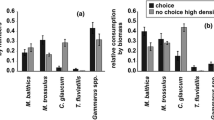Abstract
Observations on the subtidal seastar Pisaster brevispinus (Stimpson) indicate that this predator can extend the central tube feet into sand-mud substrate for a distance roughly equal to the radius of the seastar. Field and laboratory evidence demonstrates the use of the elongated tube feet by the asteroid for the capture of burrowed prey items. A relationship between predator size and the size of juveniles of the deep-burrowing clam Tresus nuttallii taken as prey is a product of the ability of larger seastars to extend the tube feet further into the substrate and capture deeper prey. The role of P. brevispinus as an important subtidal predator along the Pacific Coast of North America is discussed.
Similar content being viewed by others
Literature Cited
Ansell, A.D.: Leaping movements in the Bivalvia. Proc. malac. Soc. Lond. 38, 387–399 (1969)
Birkeland, C.: Interactions between a sea pen and seven of its predators. Ecol. Monogr. 44, 211–232 (1974)
Christensen, A.M.: The feeding behavior of the seastar Evasterias troschelii Stimpson, Limnol. Oceanogr. 2, 180–197 (1957)
—: Feeding biology of the sea-star Astropecten irregularis Pennant. Ophelia 8, 1–134 (1970)
Edwards, D.C.: Predators on Olivella biplicata, including a species-specific predator avoidance response. Veliger 11, 326–333 (1969)
Farmanfarmaian, A., A.C. Giese, R.A. Boolootian and J. Bennett: Annual reproductive cycles in four species of west coast starfishes. J. exp. Zool. 138, 355–367 (1958)
Feder, H.M.: On the methods used by the starfish Pisaster ochraceus in opening three types of bivalve molluscs. Ecology 36, 764–767 (1955)
Fisher, W.K.: Asteroidea of the North Pacific and adjacent waters. Part 3, Forcipulata (concl.). Bull. U.S. natn. Mus. 76, 1–356 (1930)
Hopkins, T.S. and G.F. Crozier: Observations on the asteroid echinoderm fauna occurring in the shallow water of southern California. (Intertidal to 60 meters). Bull. Sth. Calif. Acad. Sci. 65, 129–145 (1966)
Hyman, L.H.: The invertebrates, Vol. IV. Echinodermata, 763 pp. New York: McGraw-Hill 1955
MacGinitie, G.E. and N. MacGinitie: Natural history of marine animals, 2nd ed. 523 pp. New York: McGraw-Hill 1968
Mauzey, K.P., C. Birkeland and P.K. Dayton: Feeding behavior of asteroids and escape responses of their prey in the Puget Sound region. Ecology 49, 603–619 (1968)
Ricketts, E.F., J. Calvin and J.W. Hedgpeth: Between Pacific tides, 4th ed. 614 pp. Stanford: Stanford University Press 1968
Smith, L.S.: Clam-digging behavior in the starfish, Pisaster brevispinus (Stimpson, 1857). Behaviour 18, 148–153 (1961)
Verrill, A.E.: Monograph of the shallow-water starfishes of the Northern Pacific Coast from the Arctic Ocean to California. Part 1. Harriman Alaska Exped. (Smithson. Instn) 14, 1–408 (1914)
Author information
Authors and Affiliations
Additional information
Communicated by M.R. Tripp, Newark
Rights and permissions
About this article
Cite this article
Van Veldhuizen, H.D., Phillips, D.W. Prey capture by Pisaster brevispinus (Asteroidea: Echinodermata) on soft substrate. Mar. Biol. 48, 89–97 (1978). https://doi.org/10.1007/BF00390534
Accepted:
Issue Date:
DOI: https://doi.org/10.1007/BF00390534




